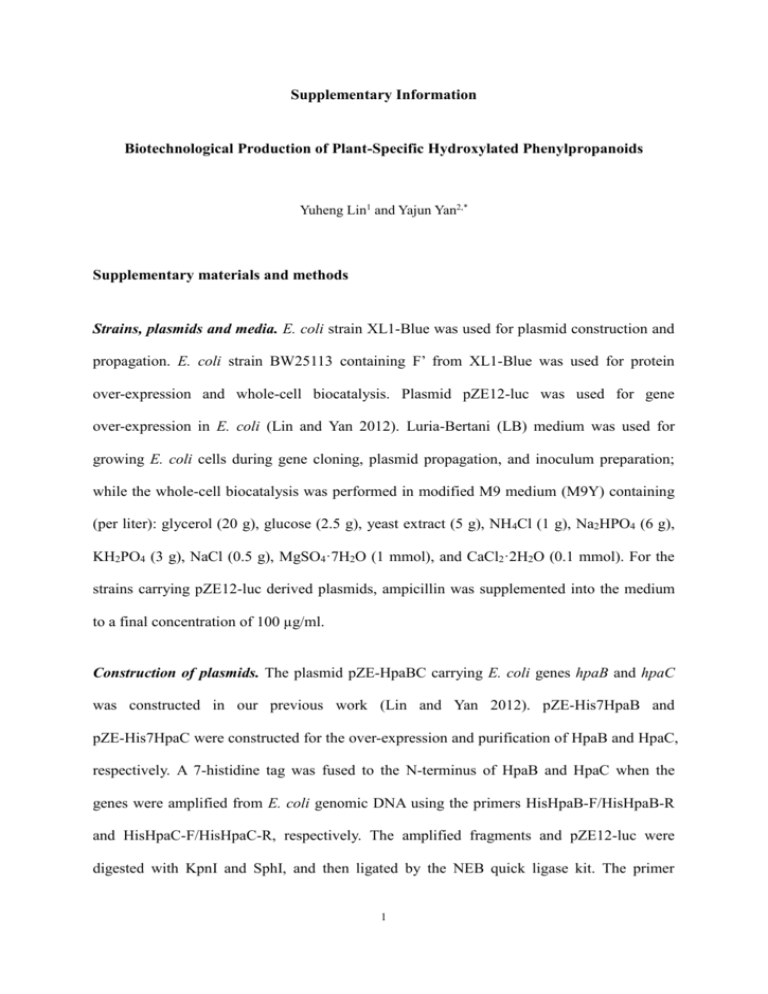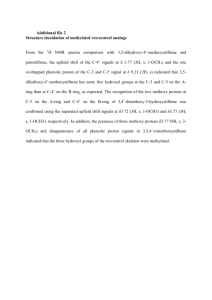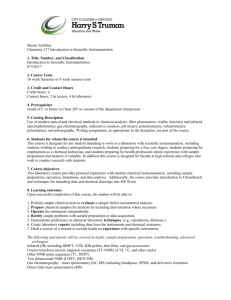bit25237-sm-0001-SuppData-S1
advertisement

Supplementary Information Biotechnological Production of Plant-Specific Hydroxylated Phenylpropanoids Yuheng Lin1 and Yajun Yan2,* Supplementary materials and methods Strains, plasmids and media. E. coli strain XL1-Blue was used for plasmid construction and propagation. E. coli strain BW25113 containing F’ from XL1-Blue was used for protein over-expression and whole-cell biocatalysis. Plasmid pZE12-luc was used for gene over-expression in E. coli (Lin and Yan 2012). Luria-Bertani (LB) medium was used for growing E. coli cells during gene cloning, plasmid propagation, and inoculum preparation; while the whole-cell biocatalysis was performed in modified M9 medium (M9Y) containing (per liter): glycerol (20 g), glucose (2.5 g), yeast extract (5 g), NH4Cl (1 g), Na2HPO4 (6 g), KH2PO4 (3 g), NaCl (0.5 g), MgSO4·7H2O (1 mmol), and CaCl2·2H2O (0.1 mmol). For the strains carrying pZE12-luc derived plasmids, ampicillin was supplemented into the medium to a final concentration of 100 µg/ml. Construction of plasmids. The plasmid pZE-HpaBC carrying E. coli genes hpaB and hpaC was constructed in our previous work (Lin and Yan 2012). pZE-His7HpaB and pZE-His7HpaC were constructed for the over-expression and purification of HpaB and HpaC, respectively. A 7-histidine tag was fused to the N-terminus of HpaB and HpaC when the genes were amplified from E. coli genomic DNA using the primers HisHpaB-F/HisHpaB-R and HisHpaC-F/HisHpaC-R, respectively. The amplified fragments and pZE12-luc were digested with KpnI and SphI, and then ligated by the NEB quick ligase kit. The primer 1 sequences are listed below (the His-tag sequences are underlined). HisHpaB-F: gggaaaggtaccatgcatcaccatcatcaccaccataaaccagaagatttccgcgc HisHpaB-R: gggaaagcatgcttatttcagcagcttatccagcatgttg HisHpaC-F: gggaaaggtaccatgcatcaccatcatcaccaccatcaattagatgaacaacgcctgc HisHpaC-R: gggaaagcatgcttaaatcgcagcttccatttccagc HpaBC substrates screening. The E. coli strain harboring pZE-HpaBC was pre-inoculated into LB liquid medium containing ampicillin (100 μg/ml) and grown overnight at 37oC. Then 200 µl of the inoculum was transferred into 20 ml of fresh M9Y medium. The E. coli cells were grown at 37 oC till the OD600 values reached around 0.6 and then transferred to 30oC and induced by 0.5 mM IPTG. After 3 hours’ protein expression, the substrates umbelliferone, resveratrol and naringenin were separately added into the cultures to a final concentration of 200 mg/L. After 12 hours’ incubation, the cell free cultures were analyzed by HPLC. NMR analysis. The produced compounds were extracted from the cultures by the same volume of acetyl acetate. Then the extracts were dried by a vacuum evaporator and re-dissolved by DMSO. Further purification was performed by collecting the product peaks using HPLC. The pure samples were obtained by acetyl acetate extraction and drying again. The NMR was run using 500-MHz Varian Unity Inova with a 5 mm Broad Band Detection Probe at 25 oC. For peak 1, 1H NMR data (500 MHz, DMSO-d6, Fig.S3) δ: 10.20 (br s, 1H, OH-7), 9.38 (br s, 1H, OH-6), 7.86 (d, 1H, 4-H), 6.97 (s, 1H, 5-H), 6.73 (s, 1H, 8-H), 6.16 (d, 1H, 3-H) and 13 C NMR data (125 MHz, DMSO-d6, Fig.S4) δ: 160.76 (C-2), 150.35 (C-7), 148.46 (C-9), 144.42 (C-4), 142.85 (C-6), 112.30 (C-5), 111.49 (C-3), 110.74 (C-10), 102.62 (C-8) are consistent with the 1H and 13 C NMR data of esculetin from SDBS (Spectral Database for Organic Compounds, SDBS No.: 23227) and previous report (Li et al. 2004). 2 For peak 2, 1H NMR data (500 MHz, acetone-d6, Fig.S5) δ: 6.26 (t, 1H, 4’-H), 6.52 (d, 2H, 2’,6’-H), 6.80 (d, 1H, olefinic H), 6.83 (d, 1H, 5-H), 6.91 (dd, 1H, 6-H), 6.95 (d, 1H, olefinic H), 7.07 (d, 1H, 2-H), 8.17 (br s, 2H, 3’-OH and 5’-OH),8.02 (br s, 1H, OH) and 7.89 (br s, 1H, OH) and 13 C NMR data (125 MHz, acetone-d6, Fig.S6) δ: 102.77 (C4’), 105.68 and 105.77 (C-2' and 6'), 113.95 (C-2), 116.35 (C-5), 120.08 (C-6), 127.02 (olefinic), 129.48 (olefinic), 130.82 (C-1), 140.94 (C-1'), 146.22 (C-4), 146.26 (C-3), 159.60 and 159.70 (C-3' and 5') are consistent with the previously reported 1H and 13C NMR data of piceatannol (Han et al. 2008). For Peak 3, 1H NMR data (500 MHz, acetone-d6, Fig.S7) δ: 5.40 (dd, 1H, 2-H), 3.14 (dd, 1H, 3a-H), 2.73 (dd, 1H, 3b-H), 5.95 and 5.96 (s, 6-H and 8-H), 7.03 (s, 1H, 2’-H), 6.87 (d, 2H, 5’-H and 6’-H), 12.17 (br s, 1H, 5-OH), , 9.56, 8.02 and 8.08 (3 other OHs) are consistent with the previously reported eriodictyol NMR data (Encarnacion et al. 1999). Ring numbering of the compounds is shown in Figure S8. Protein purification and in vitro enzyme assay. The E. coli strain was transformed with pZE-His7HpaB and pZE-His7HpaC separately. The fresh transformants were pre-inoculated in LB medium containing 100 µg/ml ampicillin and grown at 37°C aerobically overnight. In the following day, the pre-inoculums were transferred into 50 ml of fresh LB medium at a ratio of 1:100. The cultures were cultivated at 37 °C till the OD600 values reached about 0.6 and then induced by 0.5 mM IPTG. After additional 6 hours for protein expression at 30oC, the cells were harvested and the proteins were purified using His-Spin Protein MiniprepTM kit (ZYMO RESEARCH) according to the manual. The BCA kit (Pierce Chemicals) was used to estimate protein concentrations. The stock concentrations of purified HisHpaB and HisHpaC were 73.8 and 68.3 µM, respectively. The HpaBC enzyme assays were carried out according to the protocol described by Louie et al. with minor modifications (Louie et al. 2003). The 1 ml reaction system contains KPi Buffer (20 mM, pH = 7.0), FAD (10 μM), NADH (1 mM), 3 HpaB (0.5 μM), HpaC (0.5 μM), substrates (from 10 to 1000 μM). The reactions were conducted at 30°C for 1 min (for 4HPA), 10 min (for resveratrol), and 15 min (for umbelliferone) and terminated by acidification with 50 µl of HCl (20%). The reaction rates were calculated according to the product formation and substrate consumption, which were measured by HPLC. Apparent kinetic parameters were determined by non-linear regression of the Michaelis-Menten equation using OriginPro8TM. Whole-cell biocatalysis. The E. coli strain harboring pZE-HpaBC was first cultivated in 50 ml LB liquid medium at 37oC till OD600 values reached 0.6. Then the cells were transferred to 30°C and induced with 0.5 mM IPTG for additional 6 hours. After that, cells were harvested, re-suspended in 15 ml M9Y medium (OD600 = 9.6), and incubated in a rotary shaker at 300 rpm. Umbelliferone and resveratrol were separately supplemented into the cultures to a final concentration of 1.5 g/L. Meanwhile, 1.5 mM of ascorbic acid was added to avoid the spontaneous oxidation of substrates and products. When the substrate concentrations fell below 0.5 g/L, additional 1 g/L substrates were supplemented. Umbelliferone was added twice at 2.5 and 5.5 h, while resveratrol was added only once at 8 h. Samples were taken every few hours and analyzed by HPLC. HPLC analysis. Quantitative analysis of umbelliferone, resveratrol, naringenin, esculetin, piceatannol, and eriodictyol was performed by HPLC (Dionex Ultimate 3000) equipped with a reverse-phase ZORBAX SB-C18 column and an Ultimate 3000 Photodiode Array Detector. Solvent A is water containing 0.05% trifluoroacetic acid (TFA); solvent B is acetonitrile containing 0.05% TFA. The following gradient was used at a flow rate of 1 ml/min: 10 to 70 % of B for 15 min, 70 to 10% B for 1 min, and 10% B for additional 4 min. 4 Figure S1 Fig. S1 Comparison of the retention times and UV adsorption profiles of the produced compounds with those of the corresponding commercial standards. 5 Figure S2 Fig. S2 Kinetic parameters of HpaBC towards umbelliferone (A), resveratrol (B) and 4HPA (C). The Km and Vmax values were determined using OriginPro8TM through non-linear regression of the Michaelis-Menten equation. R2 values of the equations fitting for (A), (B) and (C) are 0.989, 0.991 and 0.996, respectively. Kcat values were calculated according to the formula Kcat= Vmax/[E]. Each data point is an average value of two independent experiments. 6 Figure S3 Fig. S3 1H NMR spectrum of the hydroxylated umbelliferone (predicted as esculetin) 7 Figure S4 Fig. S4 13C NMR spectrum of the hydroxylated umbelliferone (predicted as esculetin) 8 Figure S5 Fig. S5 1H NMR spectrum of the hydroxylated resveratrol (predicted as piceatannol) 9 Figure S6 Fig. S6 13C NMR spectrum of the hydroxylated resveratrol (predicted as piceatannol) 10 Figure S7 Fig. S7 1H NMR spectrum of the hydroxylated naringenin (predicted as eriodictyol). The arrow indicates a peak from unknown impurities. 11 Figure S8 Fig. S8 Ring numbering of esculetin, piceatannol, and eriodictyol. 12 Supplementary References Encarnacion DR, Nogueiras CL, Salinas VHA, Anthoni U, Nielsen PH, Christophersen C. 1999. Isolation of eriodictyol identical with huazhongilexone from Solanum hindsianum. Acta Chem Scand 53(5):375-377. Han SY, Bang HB, Lee HS, Hwang JW, Choi DH, Yang DM, Jun JG. 2008. A New Synthesis of Stilbene Natural Product Piceatannol. Bulletin of the Korean Chemical Society 29(9):1800-1802. Li L, Xu LW, Jiang YF, Xi CJ, Wang HQ, Suo YR. 2004. Isolation, characterization and crystal structure of natural eremophilenolide from Ligularia sagitta. Zeitschrift Fur Naturforschung Section B-a Journal of Chemical Sciences 59(8):921-924. Lin Y, Yan Y. 2012. Biosynthesis of caffeic acid in Escherichia coli using its endogenous hydroxylase complex. Microb Cell Fact 11(1):42. Louie TM, Xie XS, Xun L. 2003. Coordinated production and utilization of FADH2 by NAD(P)H-flavin oxidoreductase and 4-hydroxyphenylacetate 3-monooxygenase. Biochemistry (Mosc) 42(24):7509-17. 13






